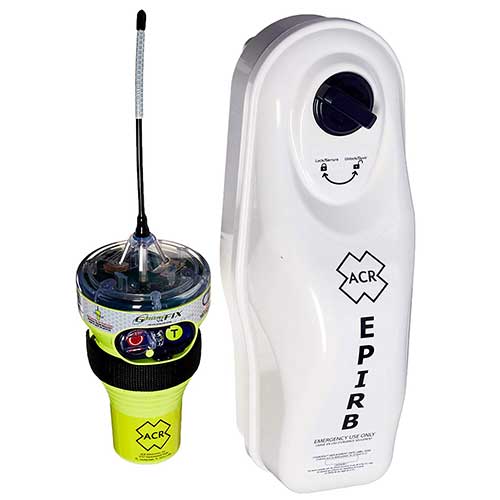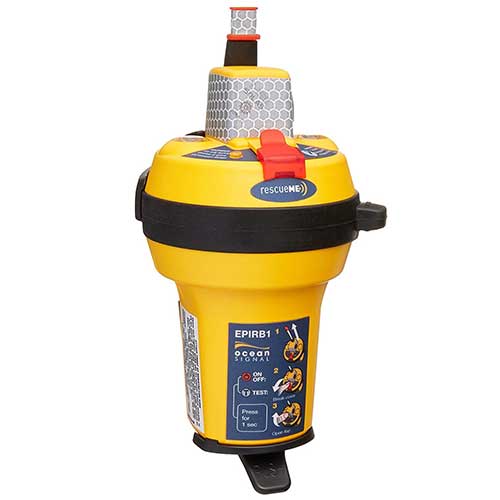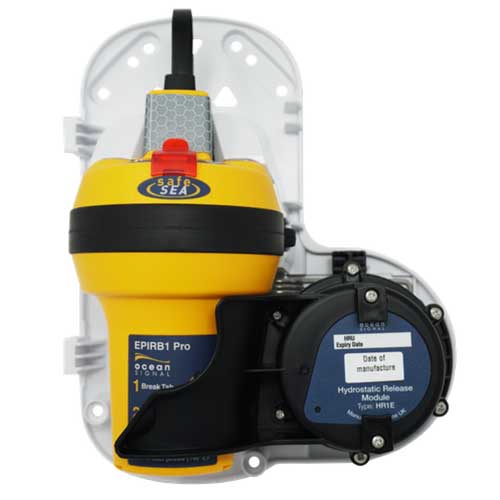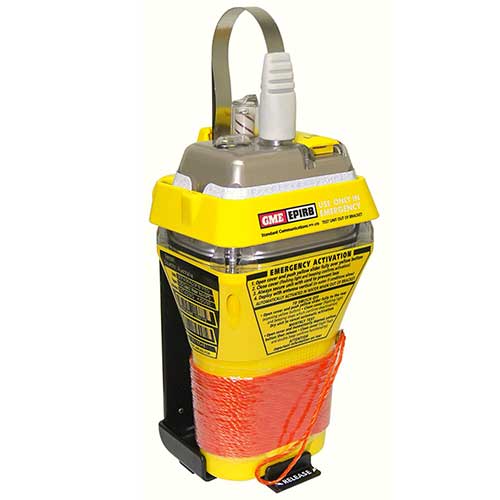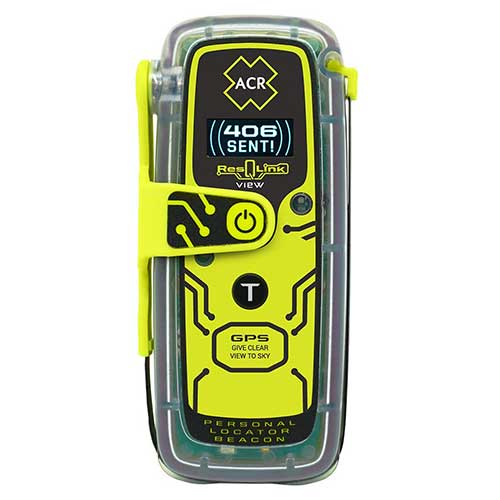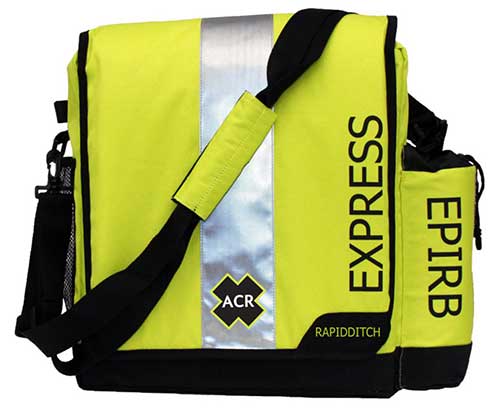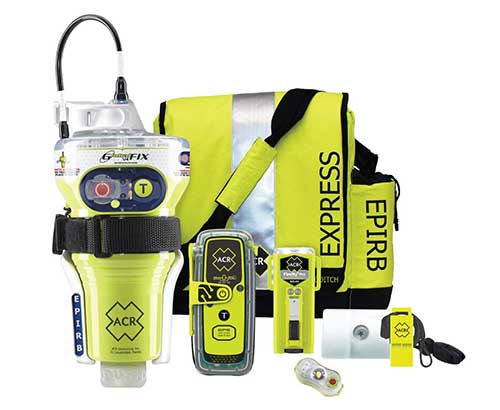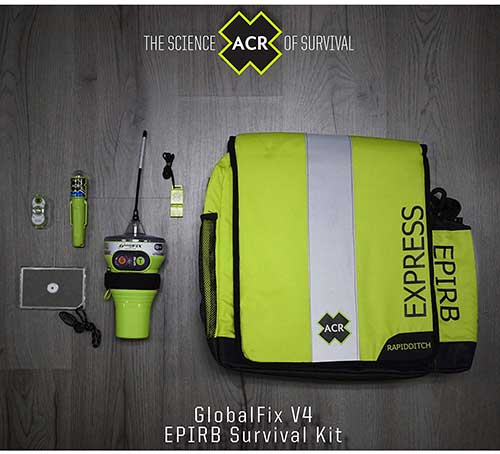EPIRB stands for Emergency Position Indicating Radio Beacon. These are registered to a boat in case of an emergency offshore. Category 1 EPIRBs containers allow the device to be activated automatically if the vessel sinks. These can also be taken out of the fixture and used manually by pushing a button.
Coast Guard inspected vessels that operate three or more miles offshore are required to have a category 1 EPIRB device. This small passenger vessel requirement is for boats that are licensed to carry more than 6 customers. The Coast Guard inspects these vessels each year for compliance with many safety requirements. Even if the device is not required it is still very important to have an EPIRB or Personal Locator Beacon PLB on board when boating offshore.
Check out the best PLB page if you are looking for small rescue beacons that can be worn on a life jacket. These are registered to an individual rather than the vessel but many PLBs send the same distress signals as EPIRBs. PLBs have to be manually activated and the distress signal can typically be sent for 24 hours or longer.
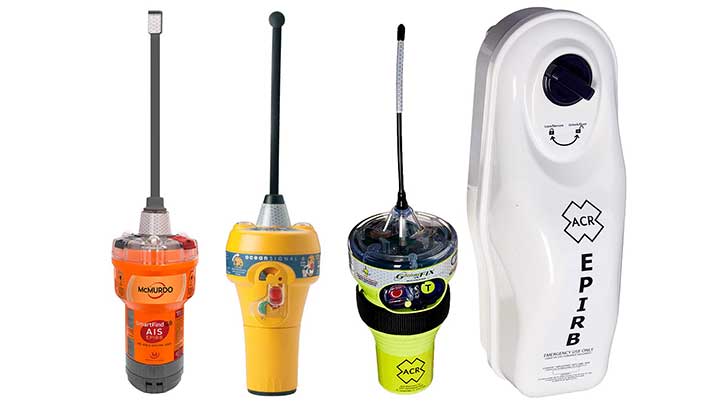
When an EPIRB is activated it sends out two signals. There is a 406 MHz signal that sends out the beacon identification number and GPS location. This information is relayed off satellites to government ground stations. The ground station then contacts the Coast Guard or appropriate agency to send help.
The second signal that the EPIRB sends out is a 121.5 MHz signal that acts as a homing beacon. Avionics on rescue helicopters have an instrument that can point to the distress signal. Rescue crews can use both the GPS position data and the homing signal to located people in distress. All of the EPIRBs in this review send out both signals.
These particular EPIRB devices can be registered with NOAA free of charge. Other satellite messaging devices that can also send rescue signals using satellites require monthly fees. Examples of these devices are Garmin inReach and Spot satellite messengers.
The other type of rescue signal sent out in a marine environment is an AIS distress signal. The AIS distress signal is sent over VHF radio frequencies using a different device altogether. This is only helpful if boats are within radio distance hear or see the distress message and respond. Some VHF radios have the technology built-in. It is still important the have an actual EPIRB or PLB when boating offshore.
Here Are the Best Emergency Position Indicating Radio Beacons EPIRBs
1. ACR EPIRB GlobalFix V4
The ACR GlobalFix V4 is the best EPIRB on the market in my opinion. Typical battery life is greater than 48 hours when in use. The waterproof rating is for a depth of 33 feet for a five-minute duration. A 5 Watt distress signal is emitted at 406 MHz with GPS coordinates plus device information and a 50 mW homing signals are emitted at 121.5 MHz. This is considered a Category 2 device as it does not have an automatic deployment bracket.
The weight of the beacon without a bracket is 1 pound 11 ounces. The battery life for the unit is 10 years from the date of manufacture. In this unit the battery is user-replaceable.
This device is category 2 and comes with a mounting bracket that does not automatically deploy the unit if the boat sinks. It can be manually activated in the bracket but will not active by water contact when in the bracket. Once the unit is out of the bracket it can be manually activated and will automatically active in the water.
A lanyard with rope allows the unit to float in the water while being connected to a liferaft. The lanyard can also be connected to a life jacket or placed on your wrist. Personally, I would hold the EPIRB in an emergency to make sure it does not drift away.
Watch this video of a center console boat that sinks coming into an inlet. This shows just how fast a boat can sink. Luckily the boater was within swimming distance of shore. Wearing a Personal Locator Beacon or having a category 1 EPIRB would be the easiest way to send for help during an emergency offshore.
2. ACR EPIRB GlobalFix V4 Category 1
The ACR GloblFix V4 Category 1 is the same EPIRB as above but has the category 1 hydrostatic release container. In the picture, the white container is what holds the EPIRB. These are designed to release when the boat sinks to a depth of 4.9 to 13.1 feet.
Having a device that automatically deploys is important because in the event of a boat crashing or flipping in rough seas. In these cases, there would likely not be enough time to get to the emergency devices. However, if the boat capsizes the device might get trapped and not deploy correctly. Also if the boat capsizes but does not sink it will not deploy properly. The EPIB can be taken out of the bracket and activated manually.
EPIRBs are great for many emergency situations. However, if you are trolling by yourself and fall overboard the EPIRB on the boat and will not help you. This is why always wearing a PLB with a life jacket is important when boating by yourself. It is also smart to have a VHF radio and a cell phone in a waterproof case. The more potential ways to call for help the better. I try to have the local Coast Guard numbers in my cell phone contacts in case I need to contact them.
Most situations on the water do not require you to contact the coast guard. If you run out of gas or have minor problems use phones and VHF radios to contact a friend or sea tow service. However, if it is a true emergency or could turn into one without assistance do not hesitate to make a mayday call and use an EPIRB.
3. Ocean Signal EPIRB US Registration
The Rescue Me EPIRB is built by Ocean Signal. It emits a 5 Watt signal at 406 MHz with GPS coordinates plus device information and a 121.5 MHz homing signal at 25-100 mW. The typical operational life is 96 hours. This device has a 10-year battery life but the batteries are user-replaceable and should be changed every 5 years.
Registration can be for the United States or for the rest of the world. There are separate listings for both of these categories. It is free to register the beacon and your contact information should be updated every two years.
A quick-release bracket comes with the device. It also has two strobes that are very helpful at night and during low visibility conditions. The antenna is retractable so the device can be stored with a small profile.
The Rescue Me EPIRB is the smallest on the market and weighs 1.2 pounds. Any manufacturing or workmanship issues are covered by a two-year warranty from the date of purchase. All service or repair work must be done by an approved service agent.
In the video below a boat capsizes after hitting something while offshore. Luckily they had a PLB on board and were able to send for help. A Coast Guard helicopter and boat in the area came to assist. It is very interesting to watch the Cost Guard response. The Coast Guard and people in distress all did a great job.
4. Ocean Signal Category 1 EPIRB
This is the same Rescue Me EPIRB from above but has a category 1 auto-release deployment system. To meet the Coast Guard requirements for a Cost Guard Inspected Vessel the EPIRB needs to be a category 1 device.
When mounting the housing it should be located as high up as possible. This helps to ensure that it will float free and not be trapped by the sinking vessel. It should also be mounted in a location that is strong enough to hold the device.
Also, consider the amount of impact the device will see while operating at this location for years. The further back it is located on the boat the less impact it will receive for waves. Keeping the device in a floating ditch bag is another option when the boat does not have to be Coast Guard inspected.
The device can also be taken out of the float fee housing and activated manually. To activate the clear cover must first be removed from the switches. Then the green switch must be held to the left while pushing the red switch down. Releasing the green switch locks the device in the active position. Two strobes on the top will flash every 2.5 seconds once activated. A lanyard on the device can be tied to a life raft to give it good sky visibility and not drift away. The device does not need to be in the water to work and you can hold the device while it is operating.
5. McMurdo EPIRB Rescue Beacon
The McMurdo SmartFind EPIRB has a 406 MHz GPS signal, 121.5 MHz homing signals, and AIS signal over VHF radio frequencies. This is the only EPIRB that sends all three signals. An important note on this unit is there is an E8 version that does not have GPS. Make sure the unit says G8 or G8 with AIS EPIRB.
The AIS is used to alert commercial vessels that have AIS electronics that someone is in distress. AIS distress is a commonly used technology that is built into many marine radios and man overboard personal locator beacons. If local vessels are in the area this provides an additional way to get help.
This unit does meet many US and international standards for rescue devices. The batteries have a 48-hour operational life and a 10-year storage life. I could not find the specification for the output power of each signal but are likely similar to other devices. A category 1 automatic deployment bracket is not included but is available for this unit.
The Cospas Sarsat system will be adding new infrastructure known as MEOSAR within the next few years. This incorporates satellites and control centers in the United States, European Union, and Russia. These integrations will allow for more accurate locations to be determined as well as faster response times.
6. GME EPIRB Satellite Rescue Beacon
The GME 600G EPIRB is a relatively new device that was designed and is manufactured in Australia by Standard Communications. GME has been making EPIRBS for over 30 years. This rescue beacon has a 6-year battery service life and a 6-year warranty on the device. The distress signals start sending 60 seconds after activation.
During operation, the device emits a 5 Watt signal at 406 MHz with GPS coordinates plus device information and a 121.5 MHz homing signal at 50 mW. The minimum operational life for the EPIRB is 48 hours. This device has a 10-year battery life but the batteries are user-replaceable and should be changed every 6 years of service.
Features of this device include a built-in self-test with an audio and visual alert, automatic deployment of the antenna, automatic activation in the water, and a high-intensity solid state strobe.
7. GME Category 1 EPIRB
The GME MT603GG float free and auto release EPIRB is the same device as GME 603 listed above. This device includes a fully enclosed float free housing with a Hammar HRU that will release the beacon when submerged at a depth of 2-4 meters.
The beacon will automatically activate when deployed in the water. It can also be activated manually. This device has a 66 Channel parallel GPS receiver and uses the Cospas-Sarsat satellite network.
Make sure you get the G version of these EPIRBs. The other devices that look the same do not have a GPS receiver. The device is factory programmed with a unique serial number which should be registered properly in the country of use. In the USA that is NOAA. The Maritime Mobile Service Identity (MMSI) number or radio call sign can also be programmed into the device at a GME authorized dealer.
8. ACR PLB Small EPIRB
This ACR Personal Locator Beacon PLB is very similar to EPIRB and many people mistakenly call it such. The main difference is that an EPIRB is registered to a vessel and a PLB is registered to an individual. The technology and distress signals sent are the same. However, a PLB typically has a minimum operating life of 24 hours. An EPIRB has a minimum operational life of 48 hours.
In reality, the best device is whichever one you have during an emergency. Ideally, boats should have an EPIRB for the vessel and a PBL for each person on board. If you have an EPIRB on the boat and fall overboard it will not do you any good. If your boat sinks and you could not get to your PLB it will not do you any good. That is why no system is full proof. Wearing a life jacket with a PLB and submersible handheld VHF radio would be a great option. Also keeping your phone on you in a waterproof case can be helpful when boating near shore. It is important to know how to pull up your GPS location and have the phone number for the local Coast Guard station.
There are several companies that make actual PLBs that use the same technology as EPIRBs. These companies are ACR, Ocean Signal, and Mcmurdo. There are other rescues distress beacons that are for individuals that use other satellite networks like the Garmin inReach and spot devices. These devices require monthly subscriptions. AIS rescue beacons are also offered by ACR and Ocean Signal and send distress signals over VHF radio to boats that are within range. It is important to understand the technology and operation of the device being operated.
In the video above I show how to use a PLB. I also test the unit to ensure the battery and GPS receiver is working properly. Then the alternative technologies to a PLB are discussed.
ACR Rapid Ditch Express Safety Bag
The Rapid Ditch Bag by ACR is a great place to keep EPIRBs and PLB devices that are not mounted in a category 1 bracket. This bag is buoyant and will float with up to 15 pounds of gear in the event it ends up in the water.
Important electronic devices to have in the bag include an EPIRB or PLB, and a VHF submersible handheld radio. Other important items to have are flares, flare gun, strobe light, waterproof flashlight, and signal mirror. An air horn or whistle to make noise is also a good idea.
Some people put food and water in the bag but it is most important to have communication and signaling devices to get help in the event of an emergency. Having a handheld GPS with the radio is a good idea so you can tell people your exact coordinates. Some people have smoke making devices to get people’s attention during the day.
When boating in cold water it is also a good idea to have full-body immersion survival suits or a liferaft. It is also important to have a properly sized life jacket for each person onboard the vessel.
9. ACR EPIRB and PLB Survival Kit
This Survival kit ditch bag includes an ACR Globalfix V4 EPIRB, an ACR ResQlink 400 PLB, LED Firefly pro strobe light, HemiLight3 strobe light, signal mirror, and a whistle. All of this gear can be stored in the express buoyant ditch bag.
LED Firefly Pro is a water-activated strobe light that lasts for a minimum of 56 hours. It does require 4 AA batteries that are not included. This device is SOLAS and US Coast Guard approved.
HemiLight3 Strobe is a survival light that can be easily attached to most lifejackets. The strobe meets USCG, MED, and SOLAS requirements. It automatically activates when it is submerged underwater. Pushing the red button turns the light off once it has been activated.
ACR GlobalFix EPIRB Survival Kit with Strobe
This EPRIB survival kit comes with a category 2 GLobalFix V4, C-strobe rescue light, HemiLight3 survivor light, Res-Q whistle, and a signal mirror. All of this can be put into the ACR rapid ditch express bag that is also included.
The c-strobe H2O rescue light is a water-activated personal distress light. Many people put these on each type 1 PFD per Coast Guard regulations. The intensity of the light is 20 lumens and lasts for about 30 hours of continuous use. The light can be turned on with a switch or automatically activated when immersed in water. It is powered by two AA batteries that are not included.
10. ACR GlobalFix Pro Category 1 EPIRB
![]()
The ACR GlobalFix Pro is the older model unit that is no longer being made. It is no longer sold but thier are still many of these still being used.
Here are the spesification though so you can compare it to the newer units. It is importat to note that the battery life for the unit is 5 years from the date of manufacture. The battery is user-replaceable. Both the Pro and V4 have a minimal output life of 48 hours although the typical performance is longer on the pro. The output power is higher on the pro but 5 watts is all that is needed in most conditions. The newer V4 is a good way to go because it is a newer model and the battery only needs to be replaced every 10 years.
Typical battery life is greater than 65 hours when in use. The waterproof rating is for a depth of 33 feet for a ten-minute duration. A 6.3 Watt distress signal is emitted at 406 MHz with GPS coordinates plus device information and a 50 mW homing signal are emitted at 121.5 MHz.
The weight of the beacon only without a bracket is 1 pound 5 ounces. The bracket has a case that protects the EPIRB from harsh weather. On the front of the bracket, there is a quick-release knob allowing the beacon to be accessed quickly without automatic deployment. At a depth from 4.9-13.1 feet, the hydrostatic release will open the case and release the EPIR which should then float to the surface. There is a magnet within the case that deactivates the water sensor while the EPIRB is in the bracket.
The Globalfix Pro has a GPS test mode that allows the internal GPS receiver function to be tested. This helps to confirm that the unit is working properly.
USCG Coast Guard Requirements for EPIRBs
Coast Guard EPIRB Requirements for Commercial Vessels
Commercial vessels that are greater than 36 feet in length and operate in high seas are required to have a category 1 EPIRB. It must be installed in a way that will allow the device to automatically float free and activate if the vessel sinks. This requirement is set by Title 46 Code of Federal Regulations (CFR). High seas are defined as the waters beyond a line three nautical miles seaward of the territorial sea baseline.
Coast Guard Inspected Vessels EPIRB Requirements for Small Passenger Vessels
Small passenger vessels EPIRB requirements are set in CRF Subchapter T Small Passenger Vessels under 100 tons Subpart B 180.64. The requirement is for vessels that are operating in high seas must have onboard an FCC accepted category 1, 406 MHz EPIRB, installed to automatically float free and activate. High seas are defined as more than three miles offshore.
Coast Guard EPIRB Requirements for Operator of Uninspected Passenger Vessels OUPV
The USCG does not require a category 1 or category 2 EPRIP. It is still very smart for vessels that operate offshore to have an EPIRB or 406 MHz Personal Locator Beacon. The device should able to be quickly accessed in the event of an emergency offshore. Having multiple ways to contact help is also also a good idea. Other methods include VHF radios, cell phones, satellite messaging devices, AIS devices, and line of sight signaling devices.
Frequently Asked Questions
If an EPIRB gets splashed or rained on will it automatically activate?
No, an EPIRB will not activate from rain or from getting splashed. Most EPIRB devices will automatically activate when tossed in the water. The device knows it is in the water because there is a conduction path between two separated metal points. There has to be enough water to complete the circuit. A small splash or rain is not enough to do this. It is a good idea to keep the EPIRB in a dry area though. If the EPIRB was sitting in a pool of water it would be enough to activate it. PLBs do not automatically activate in water and a button has to be pressed manually.
What is the best EPIRB to buy?
In the United States ACR is the largest EPIRB manufacturer. The latest model is the ACR GloblFix V4. In Australia Mcmurdo and GME are the EPIRB manufacturing companies. The devices can also be registered in the United States. Make sure that the EPIRP has a GPS receiver and sends signals over the 406 MHz frequency. EPIRBs should also send a homing signal over the VHF frequency of 121.5 MHz. In many cases, a category 1 device is the best to buy. This meets coast guard requirements for commercial and small passenger vessels that operate at high seas. In the event that the boat sinks a category 1 EPIRB is designed to float to the surface and automatically activate.
How do EPIRBs work?
EPIRBs have two ways to be activated. First, they can be manually activated by holding down a red button or switch for one second. Once activated the device acquires its exact position using GPS satellites. Once the position is determined the EPIRB sends a distress signal that includes the device serial number and location to a ground station using a 406 MHz frequency signal via satellites. The device is registered by NOAA in advance so the ground station knows who is in distress and where they are located. A local emergency rescue service like the United States Coast Guard is then contacted to assist. A 121.5 MHz homing signal is also transmitted by the device which also helps rescue crews know the device location once they are en route to the location. Strobes on the device help crews see the device once in visual range.
What does EPIRB stand for?
EPIRB stands for Emergency Position Indicating Radio Beacon. The device is registered to a vessel and as the name suggests is sends the emergency position to rescue personnel headquarters. The radio beacon part of the name is for the 121.5 MHz homing signals that are sent at VHF radio frequencies. Some people call small hand devices EPIRBs but if the device is registered to a person they are called personal locator beacons.
When should I use an EPIRB?
An EPIRB should be used when there is a true emergency and you need immediate assistance from rescue personnel. This can be on land but EPIRBs are most commonly used on the water. If it is not an emergency but you just need help it is better to use other methods of communication. Other ways to get assistance include using cell phones, VHF marine radios, or non-emergency satellite texting services. If it is not a true emergency yet but will likely become one if help does not come it is a good idea to use and EPIRB. It is better to play it safe and contact help early than wait until the situation becomes dangerous. Emergency crews are happy to help but do not want to use emergency resources for non-emergency situations.
What’s the difference between EPIRB and PLB?
The primary difference between an EPIRB and a PLB is that an EPIRB is registered to a vessel and a PLB is registered to an individual person. EPIRBs can also be put into a category 1 mounting bracket where they will automatically deploy and activate is the boat sinks. EPIRBs usually have a minimum operational life of 48 hours and PLBs have a minimum operational life of 24 hours. A PLB is also a term sometimes given to Garmin inReach and Spot satellite message devices that have distress features built it. That does not use the same satellites or technology as an EPIRB. Also, AIS personal rescue beacons use VHF radios signals to send a distress call only to boats that are within radio range.
How do I activate my EPIRB?
Category 1 EPIRBs are installed on a boat so they automatically release from their holding fixture and self-activate when a boat sinks. Category 2 EPIRBs need to be taken out of the bracket and manually activated. There are several different companies that make EPIRBs and the manual activation process is not identical across all brand types. For and ACR EPIRB the red button needs to be pressed for 1 second. To deactivate the device the red button needs to be held for 5 seconds. An ocean signal has a green switch that must be held to the left while pushing the red switch down. Releasing the green switch locks the device in the active position. McMurdo and GME have switches that need to be flipped.
It is important to read the operating instructions provided in each unit’s operating manual on how to activate the device. Instructions are also typically found on the unit itself. EPIRBs have a strobe that should be flashing about every three seconds if they are turned on. It is important to keep the device near you once it is activated. A lanyard or line is provided on the unit to secure the device to a life raft or individual.
What is the range of an EPIRB?
EPIRBs send out two signals that have different functions. The main 406 MHz distress signal with position information gets sent through satellites from anywhere in the world. The second homing beacon signal works on line of sight radio frequencies. Avionics equipment on helicopters can lock on to the frequency and travel in the direction of the signal. Once the direction of the signal flips that means they passed the location. The signal range varies but is on the order of miles. Once the rescue crew gets close they find the people in distress by looking out the window. That is why having a strobe light is important.
How much are EPIRBs?
A category 2 EPIRB costs around $450 while a category 1 EBIRB costs around $550. Category one EPIRBs can self deploy and activate if a boat sinks. If you are looking for a smaller cheaper device a PLB that works very similar to an EPIRB can be purchased for about $300. This might sound expensive but this is life-saving equipment that has been used in over 40,000 rescues in the United States alone. These devices take the search radius from miles of open ocean to a few meters. It also lets people know that you are in distress with minutes rather than hours or days without a distress signal being sent. These devices are important for boaters that boat in open waters. Even when fishing nearshore current can take the vessel miles offshore over the course of a few hours.
EPIRBs do not need to be used on large boats. They are just as important when on small boats, sailboats, or kayaks in the open ocean. Having multiple communication methods to contact help is always a good idea when operating in open water areas.
Does an EPIRB expire?
The EPIRBs device itself does not have an expiration date but the battery within the device does. Typically battery life is 5 to 10 years from the date of manufacture. Some batteries are user-replaceable and others need to be changed by the manufacturer. When changing the battery it is also important to do a GPS test to ensure the device still works. This can be done with the old battery to not use any power from the new battery. If the unit was on a boat with heavy use it might be a good idea to get a new EPIRB and keep the old device as a backup. We do the same things with PLBs. We keep the old ones as backups rather than getting new batteries. It is good to have multiple devices just in case one is broken.
Captain Cody has worked on charter fishing boats in the Florida Keys, Virgin Islands, and Alaska. Growing up in Pennsylvania Cody has also done extensive freshwater fishing including bass fishing tournaments. Cody strives to provide detailed information about the best fishing gear and tactics to help both novice and experienced anglers have a more productive and enjoyable time on the water. Cody also has a background in aerospace engineering and neuroscience but really only takes pride in being good at one thing and that is fishing!

